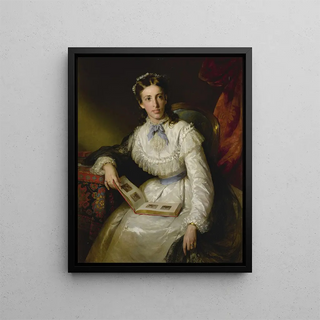Art print | Baroness Wilhelmine von Mylius - Friedrich von Amerling


View from behind

Frame (optional)
In the fascinating world of art history, certain works stand out for their ability to capture the very essence of an era. The art print of Baroness Wilhelmine von Mylius - Friedrich von Amerling is a perfect example. Painted in the 19th century, this portrait reveals not only the exceptional talent of the artist but also the spirit of a society in full transformation. The baroness, an iconic figure of Viennese high society, is depicted with a grace and dignity that transcend time. Through this painting, Amerling invites us to delve into a world of refinement and delicacy, where every detail contributes to the story told by this work.
Style and uniqueness of the work
Friedrich von Amerling's style is characterized by finesse and precision that give it an unmatched singularity. In the portrait of the baroness, delicate nuances of color and mastery of lighting highlight the elegance of her model. The texture of the fabrics, the play of light on the skin, as well as the gentle and thoughtful expression of the baroness, testify to remarkable technical skill. Amerling manages to create an intimate atmosphere, almost tangible, where the viewer is invited to contemplate not only external beauty but also the inner depth of his subject. Each brushstroke seems charged with emotion, revealing an artistic sensitivity that makes this work a true masterpiece of portraiture.
The artist and his influence
Friedrich von Amerling, born in 1803 in Vienna, is one of the most prominent portraitists of his time. His career, marked by success, reflects an era when art was freeing itself from academic conventions to embrace a more personal and expressive approach. Amerling, trained by masters of painting, developed a style that combines tradition and innovation. His influence extends beyond his personal work, inspiring many contemporary and future artists. By capturing the spirit of his era, he contributed to redefining the portrait as a genre, emphasizing the psychology of the subject rather than a simple physical representation. The baroness Wilhelmine von Mylius, as a muse, embodies this quest

Matte finish

View from behind

Frame (optional)
In the fascinating world of art history, certain works stand out for their ability to capture the very essence of an era. The art print of Baroness Wilhelmine von Mylius - Friedrich von Amerling is a perfect example. Painted in the 19th century, this portrait reveals not only the exceptional talent of the artist but also the spirit of a society in full transformation. The baroness, an iconic figure of Viennese high society, is depicted with a grace and dignity that transcend time. Through this painting, Amerling invites us to delve into a world of refinement and delicacy, where every detail contributes to the story told by this work.
Style and uniqueness of the work
Friedrich von Amerling's style is characterized by finesse and precision that give it an unmatched singularity. In the portrait of the baroness, delicate nuances of color and mastery of lighting highlight the elegance of her model. The texture of the fabrics, the play of light on the skin, as well as the gentle and thoughtful expression of the baroness, testify to remarkable technical skill. Amerling manages to create an intimate atmosphere, almost tangible, where the viewer is invited to contemplate not only external beauty but also the inner depth of his subject. Each brushstroke seems charged with emotion, revealing an artistic sensitivity that makes this work a true masterpiece of portraiture.
The artist and his influence
Friedrich von Amerling, born in 1803 in Vienna, is one of the most prominent portraitists of his time. His career, marked by success, reflects an era when art was freeing itself from academic conventions to embrace a more personal and expressive approach. Amerling, trained by masters of painting, developed a style that combines tradition and innovation. His influence extends beyond his personal work, inspiring many contemporary and future artists. By capturing the spirit of his era, he contributed to redefining the portrait as a genre, emphasizing the psychology of the subject rather than a simple physical representation. The baroness Wilhelmine von Mylius, as a muse, embodies this quest






